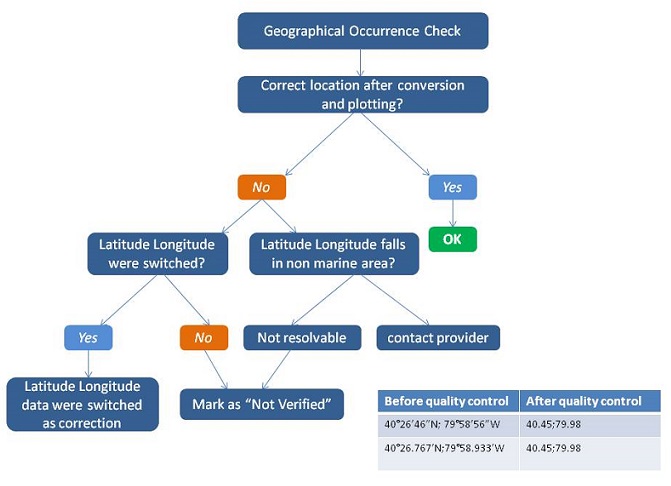Standards and Quality Control
Compiling data from different sources collected under different circumstances and with various purposes requires a minimum of standardization and quality control before sound and useful integartion becomes possible.
IndOBIS follows a number of international standards and runs a number of quality control procedures on each recieved dataset, in order to be able to estimate the quality of the provided data and to define the fitness for purpose of the data for our various users.
Data Standard: OBIS Schema
The OBIS Schema is a content specification designed to capture data about the geographical occurrences of species, e.g. the collection or observation of a particular species or other taxonomic group at a particular location. The OBIS Schema is the content standard used by OBIS. It represents an extension of the Darwin Core Version 2 and is designed for marine biodiversity data, specifically to record the capture or observation of a particular taxon at a particular location. It can also be applied to museum specimen data, which can also contribute to IndOBIS.
Taxonomic Quality Control
IndOBIS uses the World Register of Marine Species (WoRMS) as a standard list for taxonomic names. WoRMS is an authoritative taxonomic list of species occurring worldwide in the marine environment.
All taxon names are matched with WoRMS to trace and rule out spelling variations and resolve frequently used synonyms. This way, all taxon names are linked to the currently accepted name, avoiding e.g. a ‘double-count’ of the same species under different names in diversity calculations.
If a taxon does not match with WoRMS, it is matched against other authoritative taxonomic databases, such as e.g. the Integrated Taxonomic Information System (ITIS) or the Catalogue of Life (CoL). If a match can be found – and the taxon is considered marine or brackish – the taxonomic expert of WoRMS is contacted, to add the taxon to the Register. If the taxon is not marine, it will be added to an annotated list.
When taxa cannot be matched to the World Register or other authoritative taxonomic database (e.g. ITIS or CoL), the taxa are sent back to the data provider for a secondary check-up. If the data provider can provide a source containing the given taxon name, this information is sent to the taxonomic experts. They can then decide if the taxon can be added to the World Register or not.
The annotated taxon list will help IndOBIS in its taxonomic quality control, and will avoid that taxon names are sent to taxonomic editors twice for clarification.

Geographic Quality Control
All supplied coordinates are converted to the WSG84 coordinate system and expressed as decimal degrees. Next, these coordinates are checked for possible positioning errors which can include sampling locations on land or in different regions compared to the supplied metadata information. These errors can be due to accidental swapping of latitude and longitude or errors related to the use of the minus-sign. Any possible errors or doubts are communicated to the data provider, so the necessary corrections can be made. The steps involved in Geographic Quality Control is shown here:
